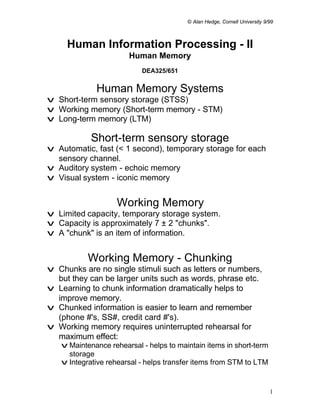Contenu connexe
Plus de Clean Agent Sdn Bhd
Plus de Clean Agent Sdn Bhd (20)
Memory
- 1. © Alan Hedge, Cornell University 9/99
Human Information Processing - II
Human Memory
DEA325/651
Human Memory Systems
v Short-term sensory storage (STSS)
v Working memory (Short-term memory - STM)
v Long-term memory (LTM)
Short-term sensory storage
v Automatic, fast (< 1 second), temporary storage for each
sensory channel.
v Auditory system - echoic memory
v Visual system - iconic memory
Working Memory
v Limited capacity, temporary storage system.
v Capacity is approximately 7 ± 2 "chunks".
v A "chunk" is an item of information.
Working Memory - Chunking
v Chunks are no single stimuli such as letters or numbers,
but they can be larger units such as words, phrase etc.
v Learning to chunk information dramatically helps to
improve memory.
v Chunked information is easier to learn and remember
(phone #'s, SS#, credit card #'s).
v Working memory requires uninterrupted rehearsal for
maximum effect:
v Maintenance rehearsal - helps to maintain items in short-term
storage
v Integrative rehearsal - helps transfer items from STM to LTM
1
- 2. © Alan Hedge, Cornell University 9/99
v Working memory can be disrupted by interference and
time decay effects.
v Working memory deteriorates with age.
Working Memory
v Time decay effects - as time passes more items are lost
from STM (forgetting).
v Interference effects (serial position effect) inhibit effective
STM processing:
v Proactive inhibition - items early in a list are remembered
better than those in the middle, and interfere with these items
as STM begins to fill.
v Retroactive inhibition - items late in a list are remembered
better than those in the middle, as STM capacity is met.
Working Memory- Serial Position Effect
Long-term Memory (LTM)
v Involves item transfer from working memory:
v Episodic memory - when and where an event occurred.
Personal experience memory.
v Semantic memory - verbal and numeric codes and their
meaning. Memory for 'facts'
v Semantic memory items stored as associative links in a
semantic net.
v Mnemonics can aid LTM performance (e.g. All Cows Eat
Grass).
Long-term Memory (LTM)
v LTM involves:
v Encoding - putting items into the store
v Decoding - retrieving items from the store:
v Recognition - familiarity with the item but unable to fully identify or
name this item.
v Recall - able to fully identify and name an item.
v Age differences in LTM.
2
- 3. © Alan Hedge, Cornell University 9/99
Long-term Memory (LTM)
v Recognition and recall use different brain regions.
Long-term Memory (LTM)
v Memory processes for 'what' and 'when' events require
different brain regions.
Long-term Memory (LTM)
v Episodic (old/new judgment) or semantic (living/nonliving decision) retrieval
tasks on old (studied) and new words.
3

